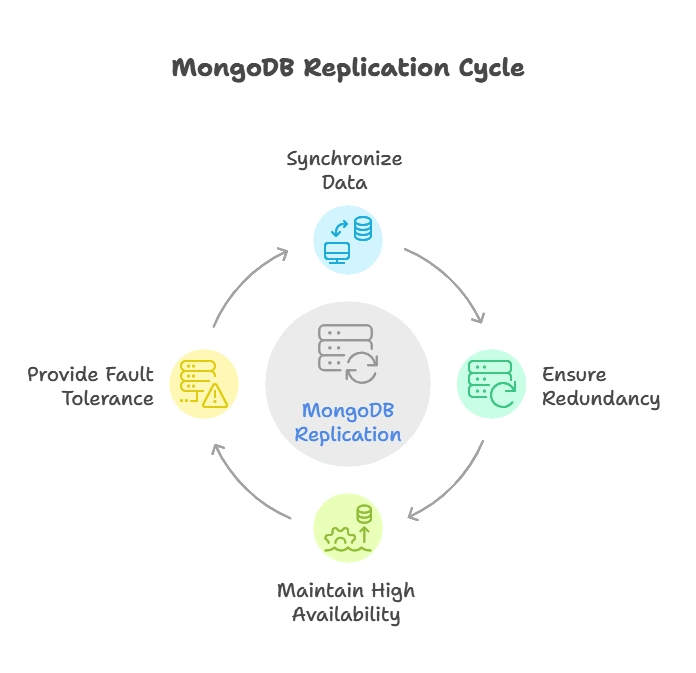Replication and High Availability
Replication and high availability are crucial components of MongoDB that ensure data redundancy, failover, and consistent performance. This chapter covers these topics from basic concepts to advanced techniques, with comprehensive examples and explanations to provide a thorough understanding.
Introduction
Replication in MongoDB involves synchronizing data across multiple servers to ensure data redundancy and high availability. This process provides fault tolerance, enabling your database to remain operational even if some servers fail.

Core Concepts
What is Replication?
Replication is the process of copying data from one server (the primary) to one or more servers (the secondaries). In MongoDB, this is achieved through replica sets.
Benefits of Replication
- High Availability: Ensures that your database remains operational even during server failures.
- Data Redundancy: Protects against data loss by maintaining multiple copies of your data.
- Scalability: Allows you to distribute read operations across multiple servers.
- Automatic Failover: Automatically promotes a secondary to primary if the current primary fails.
Setting Up Replication
Replica Sets
A replica set in MongoDB is a group of mongod instances that maintain the same data set. Replica sets provide redundancy and high availability.
Components of a Replica Set
- Primary: The node that receives all write operations.
- Secondary: Nodes that replicate the data from the primary. They can serve read operations.
- Arbiter: A node that participates in elections for primary but does not store data.
How Replica Sets Work
- Data Replication: Secondary nodes continuously replicate data from the primary node.
- Failover: If the primary node fails, an election is held among the secondaries to choose a new primary.
- Acknowledgement: The primary acknowledges write operations only after the data is replicated to a majority of the nodes.
Configuring a Replica Set
Install MongoDB on all the nodes that will be part of the replica set.
Initialize the Replica Set: Start MongoDB instances with the --replSet option.
mongod --replSet "rs0" --dbpath /data/db --port 27017
Connect to the MongoDB Shell:
mongo --port 27017
Initiate the Replica Set:
rs.initiate()
Add Members to the Replica Set:
rs.add("localhost:27018")
rs.add("localhost:27019")
Check the Replica Set Status:
rs.status()
Example Code and Explanation
rs.initiate(
{
_id: "rs0",
members: [
{ _id: 0, host: "localhost:27017" },
{ _id: 1, host: "localhost:27018" },
{ _id: 2, host: "localhost:27019" }
]
}
)
_id: Identifier for the replica set.members: Array of objects defining the members of the replica set.- Each member has an
_id(unique within the set) and ahost(address of the node).
High Availability
High availability in MongoDB ensures that the database remains operational and accessible even during hardware failures, network issues, or other disruptions.
Ensuring High Availability
- Deploy Multiple Data Centers: Distribute replica set members across different data centers.
- Use Arbiter Nodes: Add arbiter nodes to break ties during elections without adding storage overhead.
- Configuring Write Concerns: Set write concerns to ensure data is written to a specified number of replica set members before acknowledging.
Example: Write Concern
db.collection.insert(
{ name: "Alice" },
{ writeConcern: { w: "majority", wtimeout: 5000 } }
)
w: "majority": Ensures the write is acknowledged by a majority of the replica set members.wtimeout: 5000: Sets a timeout of 5000 milliseconds for the write concern.
Advanced Replication Topics
Read Preference
Read preference determines how MongoDB directs read operations to replica set members.
- Primary: Reads from the primary only.
- PrimaryPreferred: Reads from the primary if available, otherwise from a secondary.
- Secondary: Reads from secondary only.
- SecondaryPreferred: Reads from a secondary if available, otherwise from the primary.
- Nearest: Reads from the nearest node based on network latency.
Example: Setting Read Preference
db.getMongo().setReadPref("secondaryPreferred")
Delayed Replica Sets
Delayed replica sets are secondary members that replicate data with a delay.
- Useful for recovering from logical errors.
- Configured with a
secondaryDelaySecsparameter.
Example: Configuring a Delayed Replica Set
rs.add({
host: "localhost:27020",
priority: 0,
hidden: true,
secondaryDelaySecs: 3600
})
priority: 0: Prevents the delayed node from becoming primary.hidden: true: Hides the node from applications.secondaryDelaySecs: 3600: Sets a delay of 3600 seconds (1 hour).
Hidden Replica Sets
Hidden replica sets do not participate in elections and are not visible to client applications.
- Used for dedicated tasks like backups and analytics.
Example: Configuring a Hidden Replica Set
rs.add({
host: "localhost:27021",
priority: 0,
hidden: true
})
priority: 0: Prevents the node from becoming primary.hidden: true: Hides the node from applications.
Replication and high availability are critical components of a robust and resilient MongoDB deployment. By understanding and implementing replica sets, configuring write concerns, and employing strategies like delayed and hidden replica sets, you can ensure that your MongoDB database remains highly available and reliable. Happy coding !❤️
